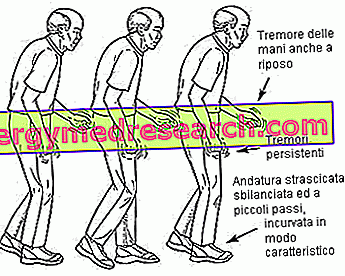Parkinson's disease is a progressive, insidious, neurodegenerative disease mainly characterized by two phases: a perisymptomatic phase and a symptomatic phase. Generally, the first or perisymptomatic phase is characterized by the loss of dopaminergic neurons of the substantia nigra, although it is not yet clear when this phase begins, nor in what percentage is the loss of dopaminergic neurons quantified.

We can however classify the symptomatic phase of Parkinson's disease into two parts: the early phase and the late phase . The first phase is characterized by the appearance of the first symptoms of Parkinson's disease, which appear when about 70% of the dopaminergic neurons of the substantia nigra have been lost. The second phase, instead, refers to the time span in which the pathology progresses. When Parkinson's is diagnosed, it can present several clinical pictures, even if the primary motor symptoms present with a certain variability between patient and patient. For example, it has been statistically observed that 70% of cases present resting tremor, which occurs more frequently in individuals with early-onset Parkinson's disease. Rigidity affects 89-99% of Parkinson's patients; bradykinesia occurs in 77-98% of cases and postural instability in 37% of affected individuals. Finally, 72-75% of patients present the asymmetric onset typical of the disease. There are different forms of Parkinson's, some have all four cardinal symptoms, in others, however, there is mainly tremor or akinesia and rigidity.
If the patient with Parkinson's disease is not subjected to any kind of treatment, the disease progresses in a disabling manner, so much so that Hoehn and Yahr have classified it in five stages .
- Stage I : we talk about slight and unilateral involvement. Stage I is characterized by the appearance of tremor in the upper limbs at rest. About a year before, other symptoms may occur, such as prodromal pain or a feeling of pain. The use of the upper limb is reduced. By carefully examining the individual, a slight rigidity, the presence of akinesia and the impairment of rapid alternating movements and finger dexterity are evident. We observe a slowing of the movements and a worsening in the repetition. In particular, during writing, there are some alterations such as flickering, difficulty in round and micrograph traits. Furthermore, facial hypomimia is often present and sometimes frontal seborrhea is found.
- Stage II: bilateral involvement with early changes in posture. The individual suffering from Parkinson's disease assumes a fixed posture, in which the trunk, hips, knees and ankles are slightly flexed. Furthermore, all movements tend to slow down gradually, resulting in the so-called bradykinesia. Patients often experience reactive depression.
- Stage III: there is a high impairment of gait, moderate general disability and the appearance of a retropulsion or propulsion. Increases the impairment of postural reflexes. It is noted in the individual suffering from Parkinson's disease an increasingly hurried and short step, with the trunk leaning forward. There is a significant slowing of walking and an increase in bradykinesia, while retropulsion and propulsion begin to induce falls. At this stage, occasionally, the patient may need help to perform certain tasks.
- Stage IV: high disability. At this stage, the individual suffering from Parkinson's disease is in greater need of assistance for performing normal daily activities and is no longer able to live alone. In stage four the patient has frequent falls and tasks requiring fine motor control are difficult or impossible.
- Stage V: complete disability occurs. Walking is impossible, and the individual with Parkinson's can no longer stand upright. When she is in bed she is in a supine and immobile position, with her head slightly bent on the trunk. He constantly has his mouth open because of dysphagia and reduced spontaneous swallowing. Fatigue to eat and often appears dehydration and cachexia. Moreover the situation is more complicated by the danger of infection due to reduced thoracic excursion and ineffectiveness of the cough reflex, for neurological bladder and for constant bed restraint. Obviously this clinical picture refers to a Parkinson's person not subjected to any drug treatment.



